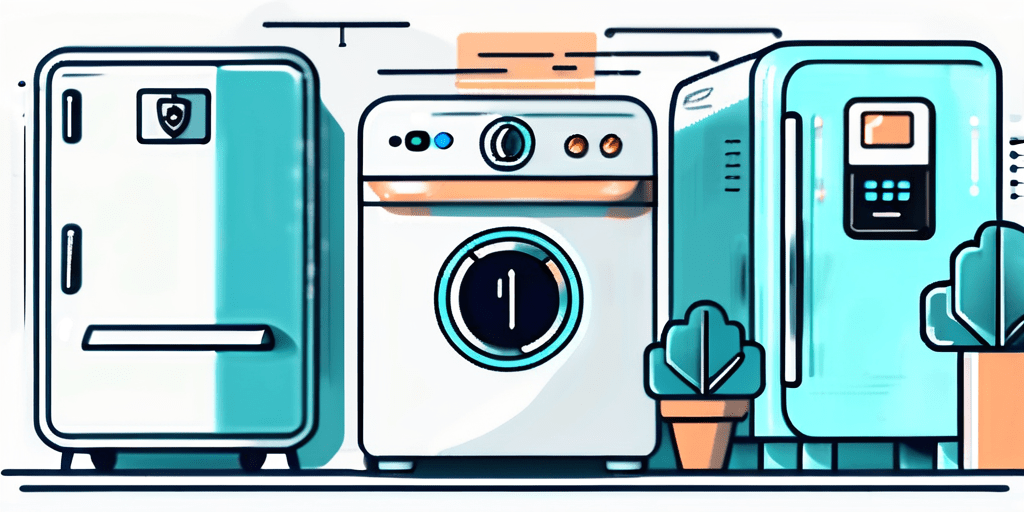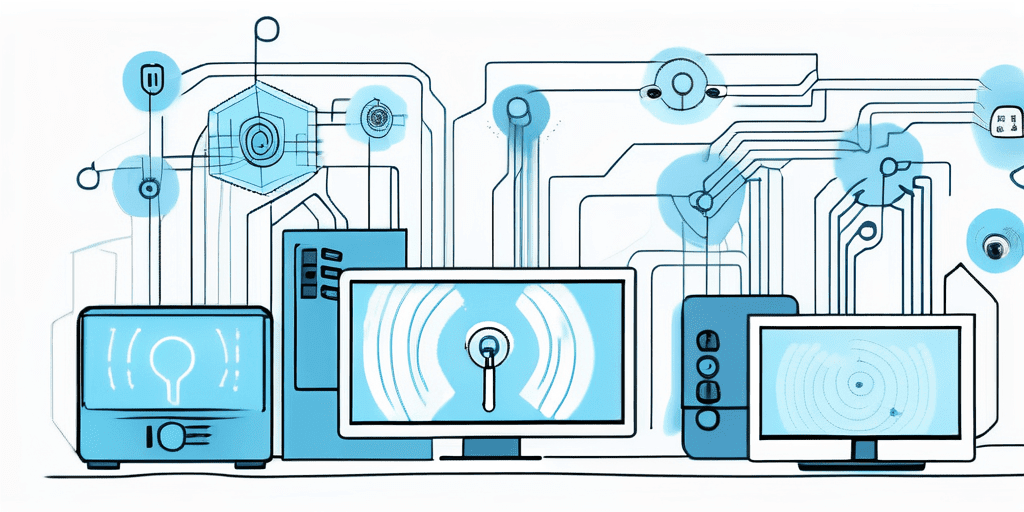With the rapid advancement of technology, the Internet of Things (IoT) has become an integral part of our everyday lives. It allows various devices to connect and communicate with each other, making our homes and workplaces smarter and more efficient. However, this convenience comes with a price — the security of these IoT devices is often compromised, leaving people vulnerable to cyber threats. In this comprehensive guide, we will explore the top unsecure IoT devices and their risks and provide insights on how to mitigate these risks.
Understanding IoT and Its Security Concerns
Defining IoT: A Brief Overview
The Internet of Things refers to the network of physical devices embedded with sensors, software, and connectivity features that allow them to collect and exchange data. These devices, ranging from smart thermostats and wearables to home security systems and industrial machinery, are designed to enhance our comfort, convenience, and productivity. However, the interconnected nature of IoT devices also makes them susceptible to security vulnerabilities.
The Importance of IoT Security
Ensuring the security of IoT devices is crucial as they handle a wealth of personal and sensitive information. From financial data to personal preferences, these devices collect and transmit a vast amount of data that hackers could exploit. Additionally, unsecure IoT devices can serve as entry points for cybercriminals to gain unauthorized access to networks, compromising personal information and critical infrastructure.
Common Security Threats in IoT Devices
Various security threats loom over IoT devices, putting users at risk. One prevalent threat is the hijacking of devices for use in large-scale botnets, as demonstrated by the Mirai botnet attack in 2016. This attack utilized unsecured IoT devices to launch Distributed Denial of Service (DDoS) attacks on websites, leading to widespread service disruption.
Another significant threat is unauthorized access to personal information. Hackers can exploit security vulnerabilities in IoT devices to access sensitive data, such as credit card details or medical records. IoT devices that monitor and control physical systems, such as home automation systems, can be manipulated to compromise safety and security.
IoT devices are not only vulnerable to external threats but also to internal risks. For example, a compromised IoT device within a network can act as a gateway for hackers to infiltrate other connected devices. This means that even a single compromised device can put an entire network at risk.
The rapid proliferation of IoT devices has led to a lack of standardization in security protocols. Different manufacturers may implement varying levels of security measures, making it challenging to ensure consistent protection across all IoT devices. This lack of uniformity exposes users to potential vulnerabilities, as hackers can exploit the weakest link in the chain of interconnected devices.
The Most Vulnerable IoT Devices
Unsecure Home Automation Devices
Home automation devices, which allow users to remotely control various aspects of their homes, are becoming increasingly popular. However, many of these devices lack basic security measures, making them an attractive target for hackers. In 2017, security researcher Ankit Anubhav discovered a flaw in several popular home automation hubs, allowing attackers to control these devices and gain access to sensitive information remotely.

The proliferation of home automation devices has raised concerns about privacy invasion. With cameras, microphones, and sensors embedded in these devices, there is a potential for unauthorized surveillance or data collection. In a recent study by a cybersecurity firm, it was revealed that certain smart home cameras were vulnerable to hacking, enabling cybercriminals to spy on unsuspecting homeowners.
Risky Wearable Tech
Wearable devices, such as fitness trackers and smartwatches, have gained immense popularity in recent years. Unfortunately, many of these devices feature inadequate security measures, leaving users’ personal health and fitness data vulnerable. In 2018, researchers at the University of Edinburgh discovered security flaws in popular fitness trackers that could potentially allow attackers to intercept and modify data transmitted between the device and associated mobile apps.
The integration of sensitive biometric data, such as heart rate and sleep patterns, in wearable devices poses a significant risk if compromised. A recent report highlighted a vulnerability in a widely used smartwatch that could lead to unauthorized access to users’ biometric information, raising concerns about the potential misuse of such personal data by malicious actors.
Insecure Smart Appliances
From smart refrigerators to voice-controlled assistants, smart appliances have revolutionized our homes. However, the rush to bring these devices to market has often resulted in inadequate security measures. In 2020, cybersecurity researchers identified a vulnerability in a popular smart doorbell that allowed unauthorized users to gain access to Wi-Fi network credentials, potentially compromising the entire home network.
In addition to the immediate security risks posed by insecure smart appliances, there are broader concerns about the implications of interconnected devices within the Internet of Things (IoT) ecosystem. The lack of standardized security protocols across different smart devices can create a domino effect, where a vulnerability in one device could lead to a chain reaction of security breaches across an entire network of interconnected IoT devices.
The Risks of Unsecure IoT Devices
Data Breach and Privacy Concerns
One of the most significant risks of unsecure IoT devices is the potential for data breaches and privacy violations. In 2019, a major hotel chain suffered a data breach through an unsecure IoT device installed in their lobby. The breach compromised the personal information of millions of guests, highlighting the importance of securing IoT devices to protect sensitive data.
Furthermore, data breaches result in financial losses for companies and erode consumer trust. When customers’ personal information is compromised, it can lead to reputational damage and legal consequences for the organization responsible. Implementing robust security measures for IoT devices is crucial in safeguarding both data and trust.
Potential for Cyber Attacks
Unsecure IoT devices can serve as entry points for cybercriminals to launch devastating cyber attacks. The 2016 Dyn cyber attack, which affected major websites including Twitter and Netflix, was carried out using a botnet composed of compromised IoT devices. This attack demonstrated the potential damage that can be caused by unsecure IoT devices and the urgency to address their vulnerabilities.
The interconnected nature of IoT devices means that a security breach in one device can have cascading effects on an entire network. Cyber attacks targeting IoT devices can disrupt critical infrastructure, compromise sensitive information, and even endanger lives. Manufacturers and users must prioritize security measures to prevent such catastrophic events.
The Threat to Personal Safety
As IoT devices become more integrated into our daily lives, the potential risks to personal safety increase. In 2021, security researchers discovered vulnerabilities in a popular smart lock that allowed attackers to unlock doors remotely. Such vulnerabilities can have far-reaching consequences, threatening the safety and security of individuals and their belongings.
Beyond physical threats, compromised IoT devices can also pose risks to personal privacy. Unauthorized access to smart cameras, voice assistants, and other connected devices can lead to intrusive surveillance and unauthorized data collection. Safeguarding personal safety in the digital age requires a proactive approach to identifying and mitigating security vulnerabilities in IoT devices.
How IoT Devices Become Unsecure
Weak Default Settings
One of the primary reasons IoT devices become unsecure is the reliance on weak default settings. Manufacturers often prioritize ease of use over security, leaving devices with default passwords or open network configurations. Hackers can easily exploit these weaknesses, gaining control of the device and potentially compromising the entire network. Users need to change default settings and passwords upon installation.

Furthermore, some manufacturers have been known to use generic default passwords across multiple devices, making it easier for hackers to gain unauthorized access. This lack of unique credentials increases the vulnerability of IoT devices and underscores the importance of setting strong, individualized passwords for each device.
Lack of Regular Software Updates
Software updates are crucial for maintaining the security of IoT devices. However, many manufacturers fail to provide regular updates, leaving devices vulnerable to known security flaws. In 2017, a widespread outbreak of the WannaCry ransomware highlighted the importance of regular updates, as many unsecure IoT devices were still running outdated and vulnerable software.
Moreover, the complexity of IoT device ecosystems, with various devices from different manufacturers interconnected, poses a challenge for timely software updates. Coordinating updates across multiple devices with different software requirements can delay patching known vulnerabilities, exposing the entire network to potential cyber threats.
Poor User Security Practices
Users themselves play a significant role in the security of IoT devices. Neglecting to update firmware, using weak passwords, and failing to secure home Wi-Fi networks all contribute to the increasing risk of IoT devices becoming compromised. Educating users on best practices for IoT security is crucial in mitigating these risks.
Additionally, the convenience of IoT devices often leads users to overlook security measures, such as two-factor authentication or network segmentation. Implementing these additional security layers can significantly enhance the protection of IoT devices and prevent unauthorized access to sensitive data.
Mitigating the Risks of Unsecure IoT Devices
Choosing Secure IoT Devices
When selecting IoT devices, it is essential to prioritize security features. Research manufacturers’ security track records and opt for devices that undergo rigorous security testing. Look for devices with strong encryption, multi-factor authentication, and automatic software updates. By choosing certified and reputable brands, users can significantly reduce the risk of unsecure IoT devices.

Moreover, it is advisable to consider the IoT device’s ecosystem and the manufacturer’s commitment to long-term support and security updates. Some manufacturers provide extended support for their products, ensuring that security vulnerabilities are addressed even as new threats emerge. Additionally, checking for independent security certifications or audits can offer further assurance of a device’s security measures.
Regularly Updating and Patching Devices
Keeping IoT devices up to date with the latest firmware and software patches is crucial for maintaining security. Manufacturers should provide regular updates to address security vulnerabilities promptly. Users must actively monitor for updates and apply them as soon as they become available.
In addition to firmware updates, users should also consider the physical security of their IoT devices. Ensuring that devices are physically secure from tampering or unauthorized access can complement software-based security measures. This includes placing devices in secure locations, using tamper-evident seals where applicable, and restricting physical access to the devices.
Implementing Strong Security Practices
Users should adopt strong security practices when using IoT devices. This includes choosing strong and unique passwords, enabling two-factor authentication whenever possible, and securing home Wi-Fi networks with strong encryption. Regularly monitoring for unauthorized activities and suspicious behavior can also help identify potential security breaches early on.
Furthermore, users should be cautious about granting unnecessary permissions to IoT devices and related applications. Limiting the data shared with these devices and reviewing privacy settings can help minimize the risk of unauthorized access to personal information. Additionally, being mindful of the permissions requested by IoT devices can prevent potential data breaches and unauthorized data collection.
The Future of IoT Security
Emerging Security Technologies for IoT
As the risks associated with IoT devices become more apparent, efforts are underway to develop innovative security technologies. For example, Blockchain technology shows promise in enhancing the security of IoT networks by providing decentralized and tamper-proof data storage and transaction verification.
Blockchain technology, which gained prominence with the rise of cryptocurrencies like Bitcoin, offers a unique approach to securing IoT devices. By creating a distributed ledger that records every transaction and making it virtually impossible to alter or tamper with the data, Blockchain technology provides a robust layer of security for IoT networks. This technology ensures that each transaction is verified by multiple participants, eliminating the need for a centralized authority and reducing the risk of unauthorized access or manipulation.
The decentralized nature of Blockchain technology makes it highly resilient to cyber attacks. Unlike traditional centralized systems, where a single point of failure can compromise the entire network, Blockchain distributes the data across multiple nodes, making it extremely difficult for hackers to breach the system. This added layer of security makes Blockchain an attractive solution for safeguarding the vast array of interconnected IoT devices.
The Role of Government Regulation
Recognizing the urgency to address IoT security concerns, governments worldwide are stepping up efforts to regulate the industry. For instance, the California IoT Security Law requires manufacturers to implement reasonable security features in their devices. Similar regulations aim to ensure baseline security standards across all IoT devices and protect consumers.
Government regulations play a crucial role in establishing a framework for IoT security. By setting minimum security requirements and holding manufacturers accountable, these regulations help mitigate the risks associated with insecure IoT devices. They also encourage manufacturers to prioritize security in the design and development of their products, fostering a culture of security by default.
However, it is important to strike a balance between regulation and innovation. While regulations are necessary to ensure the security of IoT devices, they should not stifle innovation or hinder the growth of the industry. Governments must work closely with industry stakeholders to develop flexible and adaptable regulations that keep pace with the rapidly evolving IoT landscape.
The Impact of Consumer Awareness
Consumer awareness plays a vital role in driving change in the IoT security landscape. By prioritizing security when making purchasing decisions and demanding secure devices from manufacturers, consumers can influence the market and encourage the development of more secure IoT devices. Education and awareness campaigns can help users understand the risks and take appropriate measures to keep their IoT devices secure.
With the increasing number of high-profile data breaches and privacy concerns, consumers are becoming more conscious of the security risks associated with IoT devices. They are demanding transparency from manufacturers regarding the security features and practices implemented in their products. This shift in consumer behavior is forcing manufacturers to prioritize security and invest in robust security measures to gain a competitive edge in the market.
Moreover, consumer awareness also extends to the importance of regularly updating IoT devices with the latest security patches and firmware updates. By staying vigilant and proactive in keeping their devices up to date, consumers can minimize the risk of vulnerabilities being exploited by cybercriminals.
In conclusion, as the number of IoT devices grows, the need for robust security measures becomes increasingly evident. With a comprehensive understanding of the top unsecure IoT devices and their risks, individuals can make informed choices to protect their data, privacy, and personal safety. By choosing secure devices, keeping them updated, and implementing strong security practices, we can pave the way for a more secure and resilient IoT future.
As you navigate the complexities of IoT security, remember that the right expertise can make all the difference. Blue Goat Cyber, a Veteran-Owned business, is dedicated to fortifying your cybersecurity posture. We specialize in medical device cybersecurity, penetration testing, and compliance with HIPAA, FDA, SOC 2, and PCI standards. Protect your business and stay ahead of cyber threats with our comprehensive B2B cybersecurity services. Contact us today for cybersecurity help and partner with a team as committed to your security as you are.
